January 2019 Update
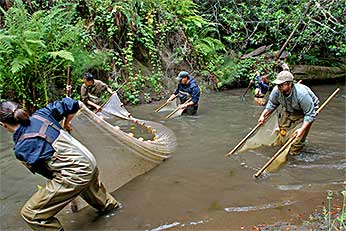 Biologists seining Redwood Creek for juvenile Coho Salmon, August 2014. CDFW photo.
Biologists seining Redwood Creek for juvenile Coho Salmon, August 2014. CDFW photo.
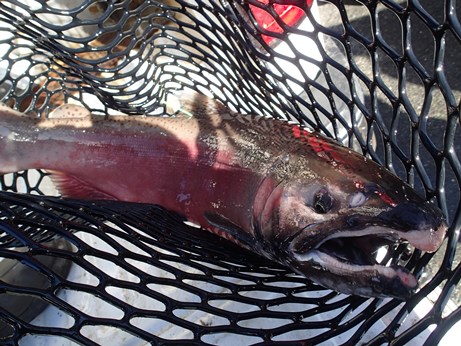 Adult Coho Salmon ready for release into Redwood Creek, 2018. CDFW photo.
Adult Coho Salmon ready for release into Redwood Creek, 2018. CDFW photo.
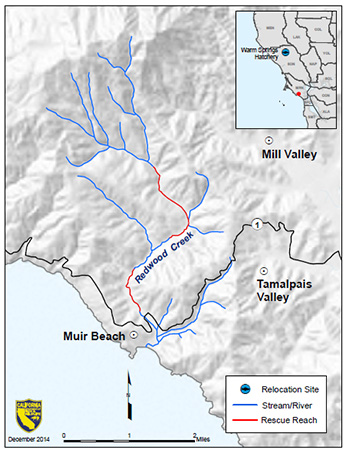 Redwood Creek flows through Muir Woods and enters the Pacific Ocean at Muir Beach. (click/tap to enlarge).
Redwood Creek flows through Muir Woods and enters the Pacific Ocean at Muir Beach. (click/tap to enlarge).
- On December 18, 2018, 165 adult Coho Salmon were released back into Redwood Creek. This marked the final year of a multi-year captive rearing program which began as an emergency rescue initiated during the summer of 2014. The primary goal of the program was to prevent local extirpation of Coho Salmon from the Redwood Creek basin. The National Park Service will continue monitoring salmonids in Redwood Creek this summer. In addition to a summary of distribution of spawning success per release location, scientists will collect tissue samples for parentage analysis. Combined with juvenile monitoring, an estimate of wild, hatchery reared, and summer population composition of Coho Salmon rearing during the summer of 2019 will be produced.
- Total Released: 165
- Females: 87 BY15 (3-year-olds)
- Males: 76 BY15 (3-year-olds)
- Immature Unknown: 2 BY15 (3-year-olds)
- Average Fork Length: 481mm, Average Weight:1588g
January 2018 Update
- On January 12, 2018, 188 adult Coho Salmon were released back into Redwood Creek.
- Total Released: 188
- Females: 89 BY14 (3-year-olds)
- Males: 87 BY14 (3-year-olds)
- Males: 12 BY15 (2-year-old "jacks")
- During the summer of 2017, approximately 180 tissue samples were collected from juvenile Coho Salmon rearing in Redwood Creek. These will be analyzed to determine parentage (offspring or "progeny" of released adults or naturally spawning origin).
- In the summer of 2018, tissue samples will be collected from rearing juveniles for the same purpose as above.
- The last cohort of approximately 200 adult Coho Salmon (BY2015 collected as juveniles in 2016) will be released in the winter of 2018/19, followed by juvenile sampling in the summer of 2019 for the same purpose as above.
December 2016 Update
2016 Juvenile Collections
- BY14 collected in 2015: 200
- BY15 collected in 2016: 202
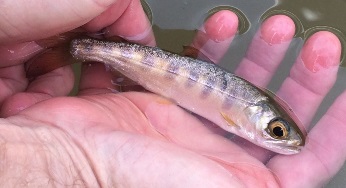 Juvenile Coho Salmon collected from Redwood Creek. CDFW photo.
Juvenile Coho Salmon collected from Redwood Creek. CDFW photo.
2016 Adult Releases
- Total: 106
- Females:69 BY12 (56 mature, 13 immature)
- Males: 34 BY12 (32 mature, 2 immature)
- Males: 3 BY14 jacks
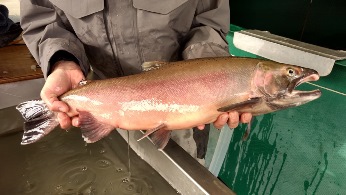 Adult Coho Salmon preparing for release into Redwood Creek. CDFW photo.
Adult Coho Salmon preparing for release into Redwood Creek. CDFW photo.
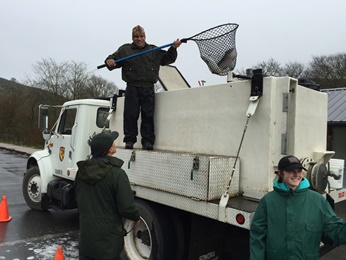 Figure 1: CDFW and ACOE staff net Coho Salmon from the hatchery tank. CDFW photo.
Figure 1: CDFW and ACOE staff net Coho Salmon from the hatchery tank. CDFW photo.
On December 9, 2016, CDFW transported adult Coho Salmon from Warm Springs Hatchery to Redwood Creek, Marin County (Figure 1). A total of 106 hatchery reared, natural origin adult Coho Salmon were released into their natal creek to spawn. This marked the completion of captive rearing of the first cohort or broodyear (BY12) of Coho Salmon collected from Redwood Creek in 2014 (see full story below). The remaining two cohorts, that were collected in the summer of 2015 and 2016 are currently being reared at Warm Springs Hatchery, Lake Sonoma.
The timing of the release was near perfect with water rising and more rain in the immediate forecast (Figure 2). All released Coho Salmon were of Redwood Creek origin. With the exception of three BY14 jacks (2-year olds), all released fish were presumably BY12 (4-year olds).
2016/2017 Monitoring
Coho Salmon previously tagged with Passive Integrated Transponders (PIT) were scanned with a hand-held reader prior to release and the number and release site recorded (Figure 3). PIT tags are used to monitor spawning distribution. Colored floy tags are also used for easy identification of live fish.. The National Parks Service and Point Reyes National Seashore Association will conduct spawner and redd surveys this winter, and juvenile monitoing is planned for the summer to estimate spawning success.
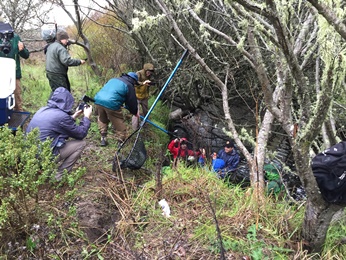 Figure 2: Agency folks and friends gather to watch Coho Salmon released to their natal creek to spawn. CDFW photo.
Figure 2: Agency folks and friends gather to watch Coho Salmon released to their natal creek to spawn. CDFW photo.
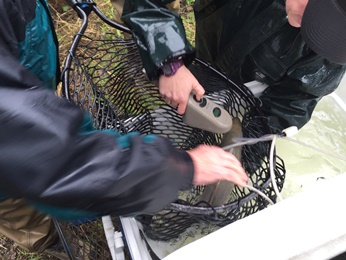 Figure 3: Biologists used a hand-held PIT reader to identify previously tagged Coho Salmon prior to release. CDFW photo.
Figure 3: Biologists used a hand-held PIT reader to identify previously tagged Coho Salmon prior to release. CDFW photo.
October 2015 Update
Juvenile Collections
- 2014 Brood Year 2012 (BY12): 129 collected, 115 remaining
- 2015 (BY14): 200 collected, 193 remaining
- 2016 (BY15): 200 (planned)
Planned Adult Releases
- Winter 2015: 3 mature males (BY12)
- Winter 2016: 112 mature Coho (BY12)
- Winter 2017: 193 mature Coho (BY14)
- Winter 2018: 200 mature Coho (BY15) (not yet collected)
All incoming juvenile Coho salmon were placed in quarantine at Warm Springs Hatchery (WSH), also known as Don Clausen Fish Hatchery (DCFH) on Lake Sonoma, and treated with oxytetracycline and formalin to prevent bacterial and fungal infections. Fish food consists of a combination of fry feed and natural krill. An inventory of BY12 conducted in late September 2015 showed that most Coho salmon in this group measured 290 mm (almost 12 inches) mean length and a mean weight of 380 g (over ¾ lb.). A few fish in this group were significantly smaller. Ultrasound (Figure 1) was the method used to determine if fish were mature, and examination revealed that only three of these Coho salmon had visible gonads (all males). As an example, figure 2 shows the ultrasound image of a mature female from the Warm Springs 2007 broodstock.
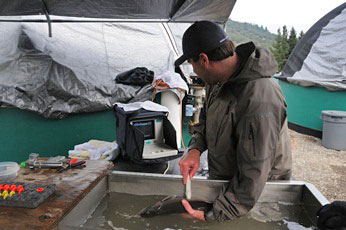 Figure 1: Program lead, Ben White (ACOE) examines adult coho salmon using ultrasound. CDFW photo.
Figure 1: Program lead, Ben White (ACOE) examines adult coho salmon using ultrasound. CDFW photo.
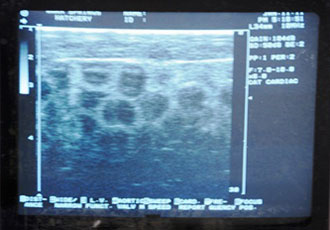 Figure 2: January 2011 ultrasound image of female coho salmon (BY 2007) showing hydrated eggs.CDFW photo.
Figure 2: January 2011 ultrasound image of female coho salmon (BY 2007) showing hydrated eggs.CDFW photo.
Facts and Highlights
Necessity of Project (2014)
The prolonged severe drought and past poor ocean rearing conditions in California are placing many endangered Coho Salmon populations at increased risk of extinction throughout the central coast. Recent annual adult Coho Salmon abundance in Redwood Creek is below 10 individuals in two brood-years and below 50 in the third brood-year. Juvenile coho abundance in 2014 is estimated below 200. Without captive rearing, there is a high risk that Redwood Creek Coho Salmon will completely disappear in the very near future.
Project Goal
To prevent extirpation of the three brood-years of Coho Salmon in Redwood Creek, temporarily increase spawner abundance, and preserve the remaining genotypes of the population.
Planned Coho Collections
p to 300 juveniles in summer 2014, 2015, 2016. Initial collection date: Aug. 13, 2014.
Rearing Facility
Warm Springs Hatchery, also known as Don Clausen Fish Hatchery at Lake Sonoma in Geyserville..
Proposed Strategy
Genetically analyze captured fish and rear in freshwater for up to three years.
Planned Coho Releases
Release as mature adults in winter of 2016, 2017, 2018.
Initial Duration and Size of Project
Five years and up to 300 fish authorized (capture, rearing and release of three consecutive brood-years plus monitoring, 2014-2019).
Collaborating Agencies
California Department of Fish and Wildlife (CDFW), NOAA National Marine Fisheries Service (NMFS), Army Corps of Engineers (ACOE), California Department of Parks and Recreation (CDPR), Golden Gate National Recreation Area - National Parks Service (GGNRA-NPS).
Project Permitting
NMFS’ Section10(a)1(A) permits issued to the Russian River Coho Salmon Captive Broodstock Program; NPS and CDPR research and collecting permit; Interagency Fish Rescue Policy (CDFW/NMFS/USFWS). Fish rescue by CDFW is exempt under CEQA.